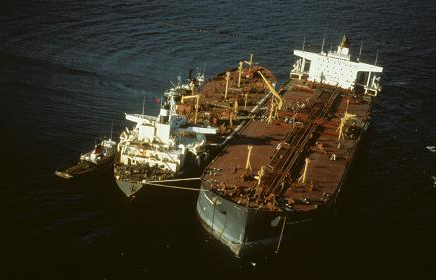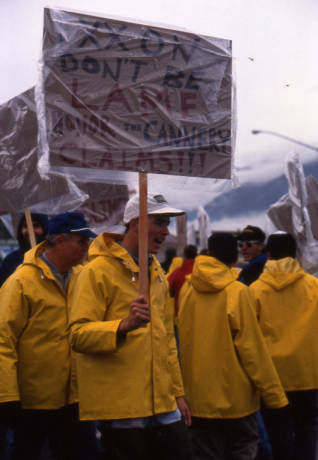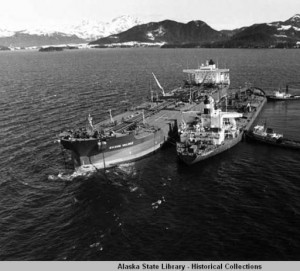Nearly three decades after the disastrous Exxon Valdez oil spill in 1989, the litigation for the remaining cash the state and federal governments could pursue from Exxon is at an end. A clause in the 1991 settlement said up to $100 million could be requested from Exxon for future unknown damage. It was called the re-opener.

In 2006, then-Governor Frank Murkowski and the George W. Bush administrations went to court and demanded $92 million of the re-opener from Exxon. The company refused to pay. And in October, the Walker and Obama administrations decided to drop the claim.
Former Marine biology professor Rick Steiner has been involved in the fight for compensation from Exxon since the spill. He says there’s no other recourse now.
STEINER: In the end it’s kind of a bitter pill at the end of this long string of bitter pills that we the people and the injured environment have suffered through for the last quarter of a century here.

TOWNSEND: Was the re-opener language written in a way that made it sort of impossible to look at it in broad enough terms to say, ‘Well, there might not be lingering effects to this particular species… but certainly to this particular species.
STEINER: The government attorneys — that’s the state attorney general’s office and the U.S. Dept. of Justice — assert that the re-opener language in the original settlement was so narrow that it was difficult to activate the claim later on down the road. However, if that’s the case, then that was a fraud initially in the settlement in 1991.
TOWNSEND: Have we, as a nation, at least learned some lessons that are being applied going forward when there are these kinds of disasters?
STEINER: I would hope that some of the lessons of the Exxon-Valdez and how to manage a disaster like this were applied in the Deepwater Horizon (spill). I was down there working on Deepwater Horizon for several years and some of those lessons were applicable — certainly the re-opener, that the debacle of the Exxon re-opener in Alaska foretold how to do it better in the BP Deepwater Horizon case. And so they did not allow BP any control over these future expenditures. Some of these lessons were applied. What were not, however — for years we pushed for a comprehensive scientific overview, or an audit, of the restoration process. Over the entire Exxon-Valdez, how restoration funds were spent — scientifically, for research, for habitat… what the difference between Exxon results were from the government research results — which were dramatically different… and the agencies opposed that. Many of the injured habitats and populations have not fully recovered. Some are listed as ‘not recovering at all,’ here 26 years later. Those include herring, pigeon guillemots, marble murrelets and the AT1 killer whale pod, which is actually expected to go extinct due to losses from the oil spill.
TOWNSEND: Does it feel strange to be at the end of this decades-long fight?

STEINER: Yeah, it does. You know, there were thousands of us who were involved in this in 1989 — actually before 1989! We saw there to be a risk for this sort of thing. Even a couple of years prior to the Exxon Valdez we tried to set up an RCAC (regional citizens advisory council) in Prince William Sound, which I still to this day believe that if we’d been successful, we would’ve seen the holes in the system and might not have ever had the Exxon-Valdez. But, there’s still more work to be done — both on lingering oil and on these larger habitat deals Bering River, Kenai Fjords, the subsurface deals in Prince William Sound and more ongoing monitoring and research that needs to be done. That will go on indefinitely. And we hope the habitat deals will get done this year. So while it’s over in one sense, it will never be over in another sense — simply from the fact that there will never be full recovery from the Exxon-Valdez oil spill. The other thing we’ve learned from this is how delicate these pristine coastal ecosystems can be to (recover) from one day, one wrong decision by a tanker captain. Here we are, 26 years later, still dealing with the fall-out from that, and still possibly with residual oil on the beaches that could be there for centuries. I guess that take-home message is, if we’re going to do these large-scale, risky developments in precious coastal areas, we have to do it with exceptional care. We aren’t there yet. We didn’t do it with the Arctic drilling (in the Chukchi) last summer, you know. Hopefully those lessons will be applied somewhere in the future. So we’re at the end of part of it… but in an interesting way, it will never be fully over.
Rick Steiner is a marine scientist and longtime critic of the Exxon Valdez settlement terms.
Lori Townsend is the news director and senior host for Alaska Public Media. You can send her news tips and program ideas for Talk of Alaska and Alaska Insight at ltownsend@alaskapublic.org or call 907-550-8452.





